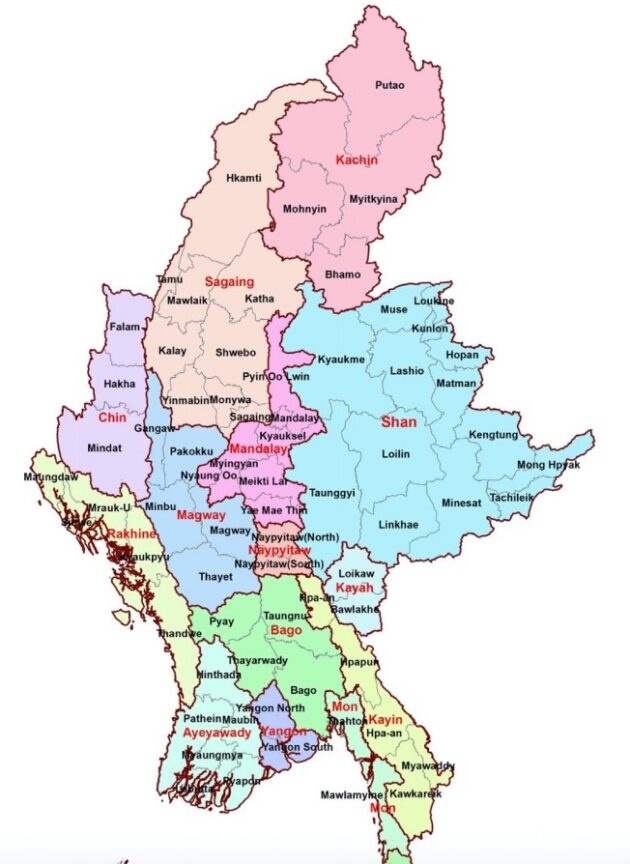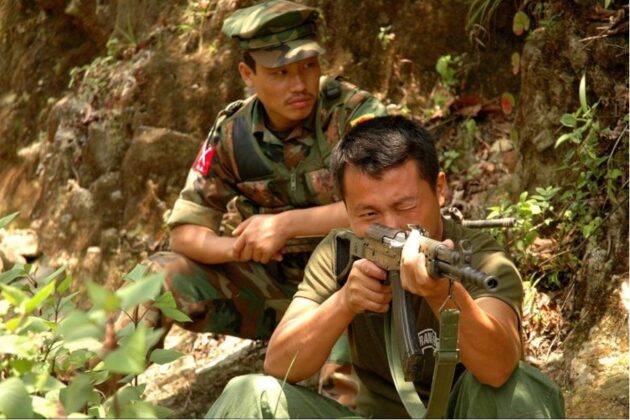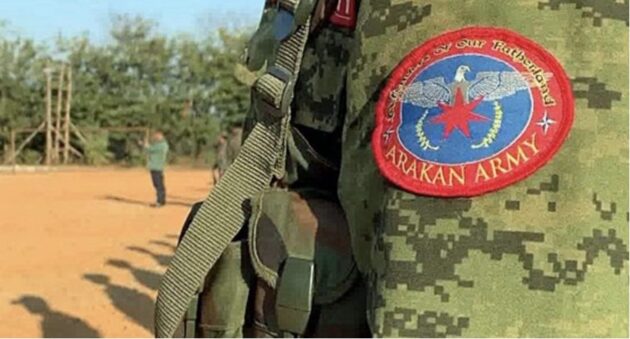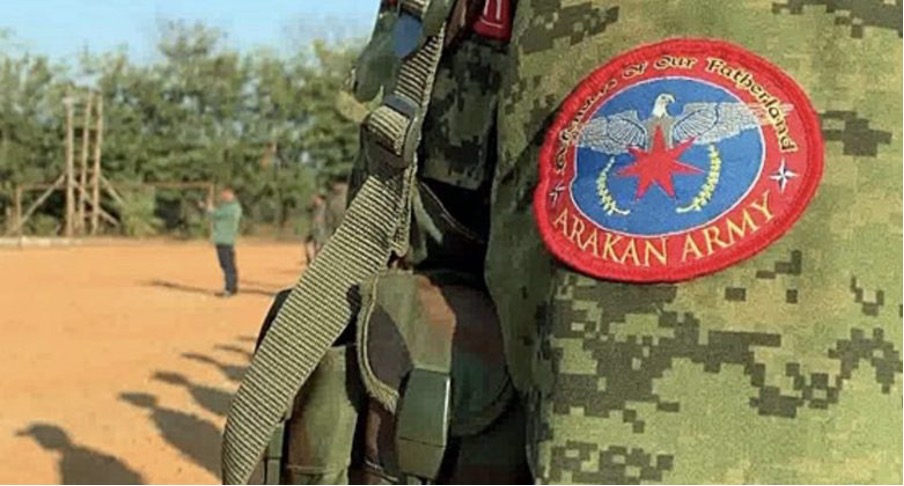9th September 2021
There have been few reports from Myanmar because it has settled down into a state of impasse. The attrition goes on as each side is wearing each other down.
The National Unity Group (NUG) has pushed for a declaration of war on the Junta and is aiming for a day of concerted action from the EAOs and PDFs. My apologies for the alphabet soup of acronyms following, but the situation is getting more complicated.
People’s Defense Forces (PDF) across Myanmar have announced an escalation in attacks on junta forces in response to the declaration of war by the shadow, civilian National Unity Government (NUG),
Several PDFs have urged residents to be alert and help resistance fighters as more fighting is expected.
In a speech on Tuesday, the NUG’s acting president Duwa Lashi La called on all citizens to “revolt against the rule of military terrorists led by coup leader Min Aung Hlaing in every corner of the country by declaring all of Myanmar to be under a state of emergency”.
A leader of the Chinland Defense Force in Mindat, which has been fighting the junta in Chin State since late April, said: “We are pleased about the NUG’s announcement about preparations for the whole country to resist the junta. We can make a move if we push together. We already have plans to force the military dictatorship out of the country.”
The Mindat resistance has inflicted heavy casualties on the military regime in the township.
On Tuesday, the Karenni Nationalities Defense Force (KNDF) in Kayah State said there have already been more operations against the regime since the declaration of a people’s war against the junta.
The KNDF has urged people not to be afraid of clashes and to cooperate with the PDF.
Source The Irrawaddy 8th September 2021.
Whilst the show of increasing co-operation is commendable from the rebels point of view, it is too early to make this sort of gesture. In the process of inflicting damage and casualties on the Junta, they run the risk of taking hits themselves. The better strategy is to take time to build capacity, increase recruitment and improve the training. They should also take the time to build supplies of weapons and ordnance. With time they will improve their capacity and logistical ability to maintain ordnance levels and strengthen supply lines.
This is supported by an opinion piece in the Asia Times by Anthony Davis, a security analyst and columnist for among others Jane’s Information Group, (military analysts).
The rains that begin in May and end in October mark a year in and year out respite in the various brush wars that have flared for decades in Myanmar’s borderlands.
But a year like no other in the country’s modern history has turned even this time-worn rhythm upside down as vicious fighting pitting the military coup regime against a plethora of ethnic insurgents and popular defense groups has continued into the rainy season.
An escalating conflict with major strategic implications has centered most recently on a swath of otherwise unremarkable farm country along the western flank of central Myanmar where the military, or Tatmadaw, is grappling with a new challenge posed by insurgents from Myanmar’s dominant ethnic Bamar community.
Cut through by the Chindwin River in the north and further south lying between the Irrawaddy River and the hills of Chin state on the Indian border, the western battleground comprises once-sleepy townships in the southern part of Sagaing and the northern stretches of Magway regions.
Armed conflict has spread to areas previously untouched by the nation’s long-running civil wars

With obscure names like Kalay, Kani, Pauk and Tilin, these rural backwaters were never on any tourist maps, lay no claim to commercial or industrial importance, and have never been touched by Myanmar’s forever insurgencies – until now.
Since April, dogged and apparently rising resistance to the military’s February power grab by local People’s Defense Forces (PDFs) is fundamentally changing Myanmar’s larger conflict map.
Areas where PDFs are active now form a broad corridor connecting major insurgent forces in the north and west of the country that have already emerged as decisive players in the struggle for Myanmar’s future.
In the north, the powerful Kachin Independence Army (KIA) has battled the Tatmadaw across Kachin and northern Shan states since March in the geographically widest and militarily hardest-hitting campaign in its 60-year insurgent history.
Since July, the ethnic armed organization – loosely estimated to field some 10,000 combatants – has also extended its operational footprint southwards into Sagaing Region, joining forces with PDFs in Shwegu and Kathe townships on the Irrawaddy River as well as further south in Kawlin and Mogok, the ruby-mining area in Mandalay Region.
In western Rakhine state on Myanmar’s Bay of Bengal seaboard, the KIA’s erstwhile protege and current ally, the Arakan Army (AA) – perhaps 8,000-9,000 strong – has suspended a blistering two-year war with the Tatmadaw and has turned its attention to consolidating its forces and control under the cover of a ceasefire.
To call the land corridor between these two powerful insurgent armies Myanmar’s Ho Chi Minh Trail would risk hyperbole.
But between 2015 and the present it has certainly acted as a vital and generally overlooked logistics conduit through which arms from northern Myanmar – both Chinese and KIA-manufactured – have flowed south along narrow, unpoliced country roads into the southern Chin hills and to the AA’s main forces in the northern townships of Rakhine state.

The AA’s leadership has remained based in the north near the KIA’s capital of Laiza on the Chinese border. But as arms flowed south, its forces in Rakhine state grew slowly from a few hundred combatants in 2015 to at least 6,000 by late 2018.
Even as war clouds gathered over Rakhine state, this writer (Anthony Davis) spent two weeks in November 2018 crisscrossing the western corridor on a rented motorcycle and was amazed never once to encounter a police or army checkpoint.
The AA build-up was unfolding essentially unnoticed by a military that would soon pay dearly for an intelligence failure of historic proportions.
The war that finally erupted in Rakhine state in January 2019 lasted until a ceasefire took hold in November 2020. Large-scale semi-conventional confrontations routinely involved Tatmadaw heavy artillery and airstrikes and often high casualties on both sides.
Notwithstanding its losses, however, the AA emerged as victor by default. As the Tatmadaw has scaled back its war-time force levels to counter post-coup unrest and insurgent offensives across many other parts of the country, the Rakhine nationalist rebels have had the time and space to extend their grip over most of Rakhine state while reinforcing nascent structures of parallel government.
After mandating Covid-19 containment measures for the public in July, the AA announced in August that its own courts run by its political wing, the United League of Arakan (ULA), would be open to make rulings on local disputes. By then, the group already fielded an embryonic police force separate from national police and its own military units.
As it continues to expand its forces, the AA’s control of territory has effectively confirmed its position as one of Myanmar’s three most consequential ethnic forces, alongside the KIA and the 30,000-strong United Wa State Army (UWSA).
Indeed, AA commander Twan Mrat Naing has clearly articulated ambitions to achieve in the country’s west a facsimile of the sweeping autonomy that the China-backed UWSA has established in the northeast in Shan state.
These are developments that the Tatmadaw, now tied down by the catastrophic results of its own February seizure of power can only watch with mounting alarm. For the time being at least, it has neither the time nor the manpower to bring the AA to heel. If and when it does turn to the AA challenge, it may already be too late.

Myanmar’s insurgent Arakan Army has deployed hit-and-run tactics the military has found difficult to counter and combat.
Against this backdrop, it is hardly surprising that local PDFs that have emerged along the south Sagaing–northern Magway corridor have succeeded in tapping into a flow of arms, tactics and technology that have enabled them to become the most active in the country.
How far this development has been proactively encouraged by either the KIA or AA, or both in concert, is difficult to gauge.
What is clear is that the large, improvised landmines currently being used by PDFs along the western corridor owe much to KIA know-how; that clashes taking place involve insurgents equipped with a lot more than antique hunting rifles; and that the growth of an increasingly active front on the Tatmadaw’s western flank serves the strategic interests of both the KIA and the AA.
Like the Ho Chi Minh trail of the Vietnam War, the corridor does not depend on one road. The logistics conduit appears to involve a network of backroads linking townships close to the Irrawaddy such as Yesago with others further west such as Pale and Kyaw.
Some arteries are clearly more important than others. Most notable is the long 130 kilometer stretch of narrow, sealed road running south from Kalay nestled at the foot of the sharply rising massif of the Chin Hills in Sagaing, to Gangaw, a pretty little town set in rolling hills in northern Magway.
The site of repeated landmine attacks on security force vehicles and convoys, this remote road has become what one corporate security firm described in an August report as “one of the most dangerous… in the country.”
The proximity of some western PDFs to the Chin Hills has also prompted the emergence of new alliances between ethnic Bamar and Chin resistance groups.
On July 26, the Mindat branch of the Chinland Defense Force (CDF) – the vanguard of anti-Tatmadaw insurgency in Chin state – announced an alliance with the newly formed Yaw Defense Force (YDF), which operates across the three Magway townships of Gangaw, Tilin and Saw.
In recent weeks, the Tatmadaw’s response to this emergent threat has escalated sharply in a manner that ties down and bleeds army units and clearly benefits the KIA and the AA. Raids on villages, proactive and retaliatory, have become near-daily occurrences and involved columns of Tatmadaw forces descending on rural communities to round up suspects, loot and burn houses.
Broader sweeps, or “clearance operations”, have targeted wider areas and reportedly involved newly raised Pyu Saw Htee militia bands supporting army units as guides, informers and local security enforcers.
The latest such sweep unfolded at the end of August in Pauk township in Magway where the local PDF has proved adept at landmine attacks on Tatmadaw vehicles.
According to a report on The Irrawaddy news site, a hundred or so troops targeted several villages and adjacent forests. On August 31, the Tatmadaw used “artillery” – most likely mortars – against Wun Chone village. The entire operation reportedly forced an estimated 30,000 people to flee.
Army raids have occasionally exploded into massacres of villagers suspected of links with insurgents – a Tatmadaw operating procedure traditionally reserved for ethnic minority communities, not least the Muslim Rohingya.
According to opposition sources and media reports, late July operations in Kani township on the Chindwin River saw soldiers execute at least 15 villagers, later found and photographed with their hands trussed behind their backs.
The incident was further amplified at the United Nations, where on August 4 Myanmar’s defiantly anti-military representative Kyaw Moe Tun wrote a letter to Secretary-General Antonio Gutteres detailing more than one massacre in the Kani sweep and appealing for “urgent humanitarian intervention.”
Whether Tatmadaw tactics will succeed in cowing opposition along the corridor is not obvious. While sweeps and raids targeted at rebellious villages can displace populations for a time, manpower constraints largely preclude the possibility of effectively garrisoning wide swaths of rural country.
Repeated attacks on convoys and troop movements are likely over time to constrict the number of roads that can be even partially secured, potentially leading to the creation of “no-go” zones where Tatmadaw forces can penetrate only with major offensives.
The stakes in western Myanmar are high for the junta. The emergence of an insurgent-dominated zone stretching unbroken from Kachin state in the north to the Bay of Bengal in the west would confront the Naypyidaw regime with a strategic challenge of daunting proportions.
Source, Anthony Davis, Asia Times 7th September 2021.
Please share this BFD article so others can discover The BFD.

